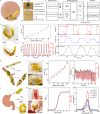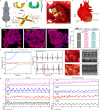Skin-inspired, sensory robots for electronic implants
- PMID: 38839748
- PMCID: PMC11153219
- DOI: 10.1038/s41467-024-48903-z
Skin-inspired, sensory robots for electronic implants
Abstract
Drawing inspiration from cohesive integration of skeletal muscles and sensory skins in vertebrate animals, we present a design strategy of soft robots, primarily consisting of an electronic skin (e-skin) and an artificial muscle. These robots integrate multifunctional sensing and on-demand actuation into a biocompatible platform using an in-situ solution-based method. They feature biomimetic designs that enable adaptive motions and stress-free contact with tissues, supported by a battery-free wireless module for untethered operation. Demonstrations range from a robotic cuff for detecting blood pressure, to a robotic gripper for tracking bladder volume, an ingestible robot for pH sensing and on-site drug delivery, and a robotic patch for quantifying cardiac function and delivering electrotherapy, highlighting the application versatilities and potentials of the bio-inspired soft robots. Our designs establish a universal strategy with a broad range of sensing and responsive materials, to form integrated soft robots for medical technology and beyond.
© 2024. The Author(s).
Conflict of interest statement
The University of North Carolina at Chapel Hill (No. 035052/602726: filed on Oct. 13, 2023) filed a provisional patent application, titled “Skin-inspired, sensory robots for electronic implants”, surrounding this work, where W.B. and L.Z. are the co-inventors. The remaining authors declare no competing interests.
Figures






Update of
-
Skin-inspired, sensory robots for electronic implants.Res Sq [Preprint]. 2023 Dec 22:rs.3.rs-3665801. doi: 10.21203/rs.3.rs-3665801/v1. Res Sq. 2023. Update in: Nat Commun. 2024 Jun 5;15(1):4777. doi: 10.1038/s41467-024-48903-z. PMID: 38196588 Free PMC article. Updated. Preprint.
Similar articles
-
Skin-inspired, sensory robots for electronic implants.Res Sq [Preprint]. 2023 Dec 22:rs.3.rs-3665801. doi: 10.21203/rs.3.rs-3665801/v1. Res Sq. 2023. Update in: Nat Commun. 2024 Jun 5;15(1):4777. doi: 10.1038/s41467-024-48903-z. PMID: 38196588 Free PMC article. Updated. Preprint.
-
Electronic skins and machine learning for intelligent soft robots.Sci Robot. 2020 Apr 22;5(41):eaaz9239. doi: 10.1126/scirobotics.aaz9239. Epub 2020 Apr 22. Sci Robot. 2020. PMID: 33022628 Review.
-
Softworms: the design and control of non-pneumatic, 3D-printed, deformable robots.Bioinspir Biomim. 2016 Mar 10;11(2):025001. doi: 10.1088/1748-3190/11/2/025001. Bioinspir Biomim. 2016. PMID: 26963596 Review.
-
Fish-inspired robots: design, sensing, actuation, and autonomy--a review of research.Bioinspir Biomim. 2016 Apr 13;11(3):031001. doi: 10.1088/1748-3190/11/3/031001. Bioinspir Biomim. 2016. PMID: 27073001 Review.
-
Biomimetic vibrissal sensing for robots.Philos Trans R Soc Lond B Biol Sci. 2011 Nov 12;366(1581):3085-96. doi: 10.1098/rstb.2011.0164. Philos Trans R Soc Lond B Biol Sci. 2011. PMID: 21969690 Free PMC article. Review.
Cited by
-
Advanced Robotics for the Next-Generation of Cardiac Interventions.Micromachines (Basel). 2025 Mar 22;16(4):363. doi: 10.3390/mi16040363. Micromachines (Basel). 2025. PMID: 40283240 Free PMC article. Review.
-
Ultrathin crystalline silicon-based omnidirectional strain gauges for implantable/wearable characterization of soft tissue biomechanics.Sci Adv. 2024 Oct 11;10(41):eadp8804. doi: 10.1126/sciadv.adp8804. Epub 2024 Oct 9. Sci Adv. 2024. PMID: 39383239 Free PMC article.
-
Recent Advances in Natural-Polymer-Based Hydrogels for Body Movement and Biomedical Monitoring.Biosensors (Basel). 2024 Aug 27;14(9):415. doi: 10.3390/bios14090415. Biosensors (Basel). 2024. PMID: 39329790 Free PMC article. Review.
-
Wearable Arduino-Based Electronic Interactive Tattoo: A New Type of High-Tech Humanized Emotional Expression for Electronic Skin.Sensors (Basel). 2025 Mar 28;25(7):2153. doi: 10.3390/s25072153. Sensors (Basel). 2025. PMID: 40218664 Free PMC article.
-
Nature-inspired surface modification strategies for implantable devices.Mater Today Bio. 2025 Feb 25;31:101615. doi: 10.1016/j.mtbio.2025.101615. eCollection 2025 Apr. Mater Today Bio. 2025. PMID: 40115053 Free PMC article. Review.
References
-
- Choi H, et al. Adhesive bioelectronics for sutureless epicardial interfacing. Nat. Electron. 2023;6:779–789. doi: 10.1038/s41928-023-01023-w. - DOI
MeSH terms
Grants and funding
- 1R01EB034332-01/Foundation for the National Institutes of Health (Foundation for the National Institutes of Health, Inc.)
- P30 CA016086/CA/NCI NIH HHS/United States
- ECCS-2025064/National Science Foundation (NSF)
- R01 EB034332/EB/NIBIB NIH HHS/United States
- ECCS-2139659/National Science Foundation (NSF)
LinkOut - more resources
Full Text Sources

